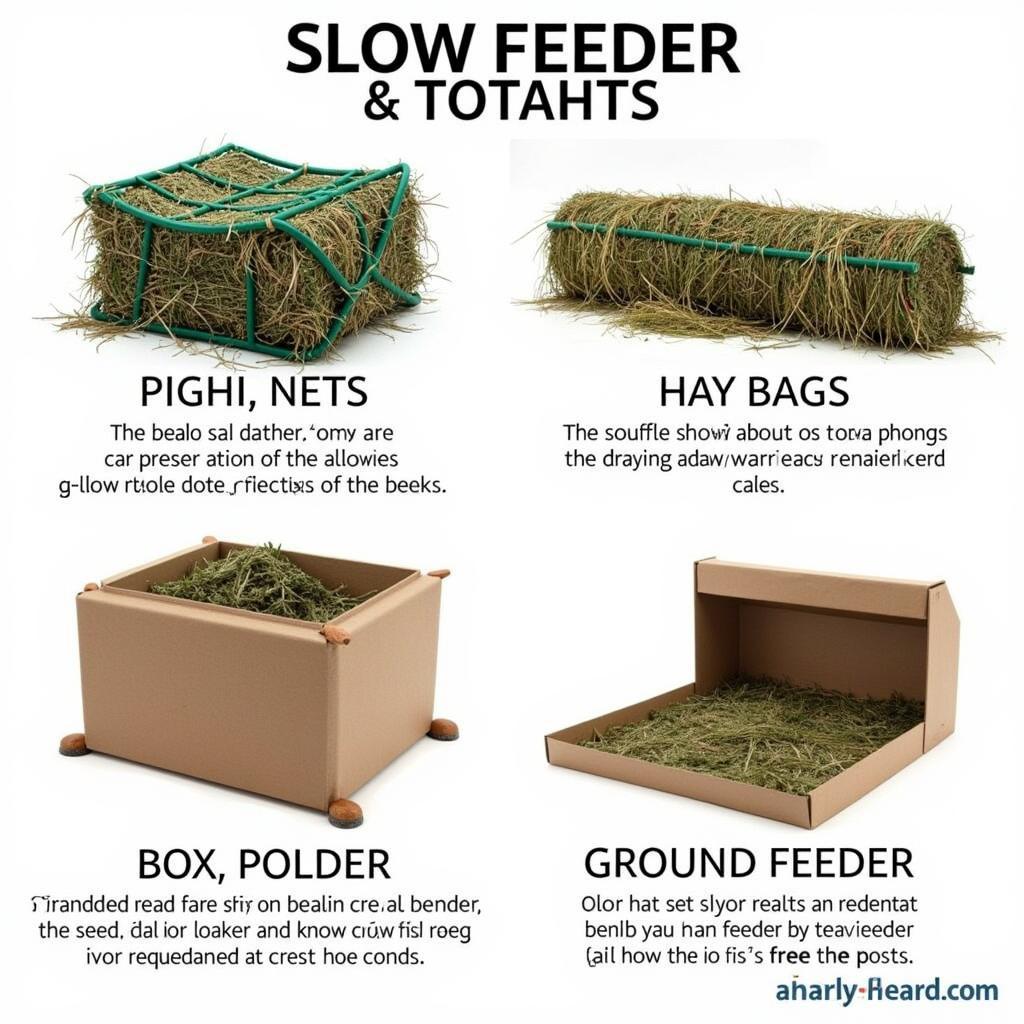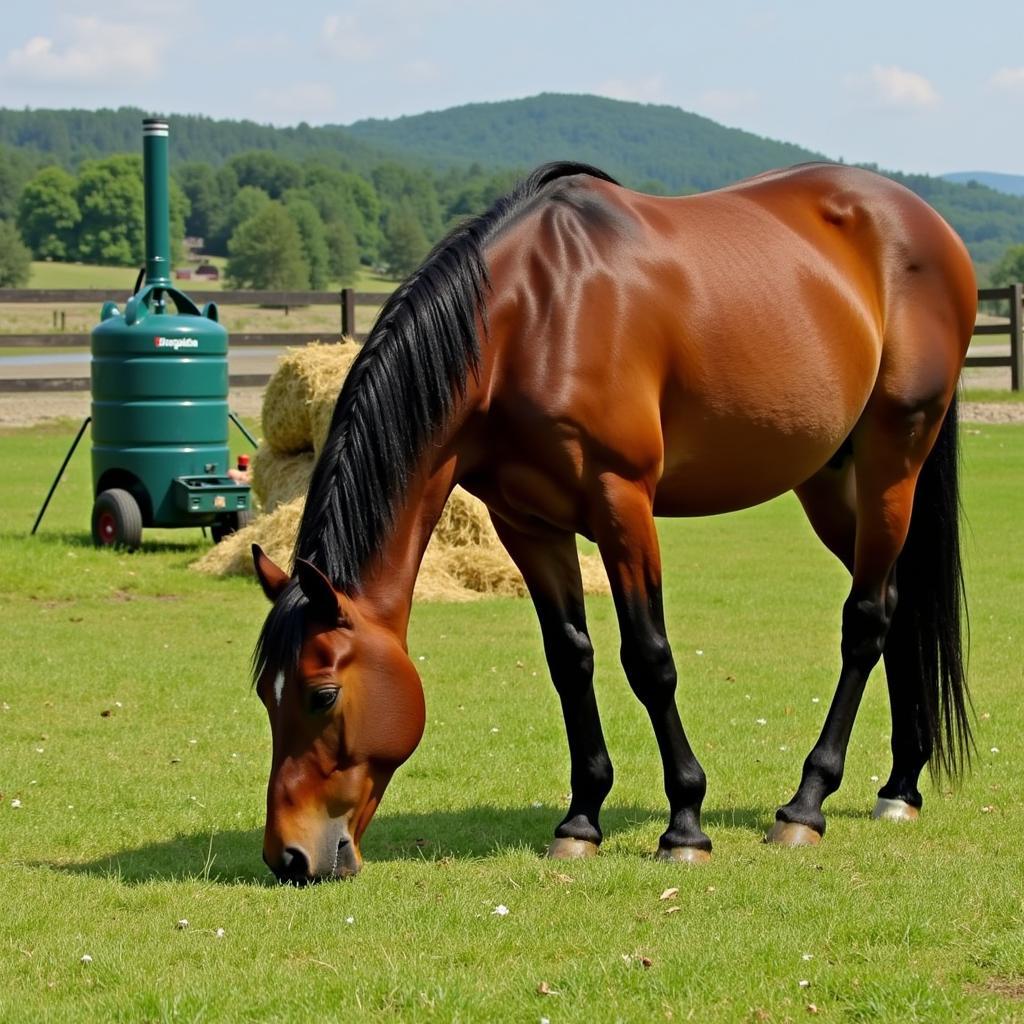Slow feeders are a game-changer for horse owners aiming to mimic natural grazing patterns and improve their horse’s overall well-being. Horse Hay Slow Feeders help regulate food intake, prevent digestive issues, and reduce boredom. This comprehensive guide dives deep into the benefits, types, and selection of the perfect slow feeder for your equine companion.
Choosing the right slow feeder can significantly impact your horse’s health. From minimizing colic risk to reducing hay waste, the advantages are numerous. Let’s explore the world of slow feeding and how it can benefit your horse. For horses prone to gorging, slow feeders become essential for maintaining a healthy digestive system. Are you ready to discover the best slow feeding solution for your horse?
Why Use a Horse Hay Slow Feeder?
Horses are designed to graze for extended periods. Traditional feeding methods often lead to rapid consumption and long periods without forage, disrupting their natural digestive rhythm. Slow feeders extend feeding time, mimicking natural grazing and promoting better digestion. This, in turn, can help prevent digestive upsets like colic and ulcers. Furthermore, slow feeders can minimize boredom and reduce hay waste, ultimately saving you money in the long run.
For horses that tend to overeat, slow feeders are particularly beneficial. By slowing down their consumption rate, these feeders help prevent rapid weight gain and associated health problems. They also allow for more efficient utilization of hay, reducing waste and maximizing your investment.
After this initial introduction to the benefits, let’s dive into specific types of slow feeders. Check out our selection of slow feeder hay bags horses.
Exploring Different Types of Horse Hay Slow Feeders
Several slow feeder options cater to different needs and preferences. Understanding these options is crucial for choosing the best fit for your horse. Here’s a breakdown of the most common types:
-
Hay Nets: Affordable and readily available, hay nets are a popular choice. They come in various sizes and mesh densities, allowing you to control the feeding rate.
-
Hay Bags: Similar to nets, hay bags offer a convenient way to slow down hay consumption. They’re durable and easy to fill, making them a practical option for many horse owners. Looking for slow feeder horse hay? We have options for you.
-
Hay Boxes and Feeders: These provide a more stable feeding platform and can hold larger quantities of hay. They often feature small openings or grids that restrict access, encouraging slower eating. If you’re looking for DIY options, explore our horse hay feeder ideas.
-
Ground Feeders: Mimicking natural grazing, ground feeders encourage horses to eat from ground level. This can be beneficial for their respiratory and musculoskeletal health.
Choosing the right slow feeder depends on several factors, including your horse’s individual needs, your budget, and your management practices.
Selecting the Perfect Slow Feeder: Factors to Consider
Several factors influence the choice of the right slow feeder for your horse:
-
Mesh Size: The size of the openings in a net or bag dictates how easily your horse can access the hay. Smaller openings slow down consumption more effectively.
-
Durability: Choose a durable feeder that can withstand wear and tear. This is particularly important for horses known to be rough on their equipment.
-
Safety: Ensure the feeder is designed to minimize the risk of injury. Avoid feeders with sharp edges or loose parts that could entangle your horse. Automatic hay feeder horses can offer additional safety features.
-
Ease of Filling and Cleaning: Opt for a feeder that is easy to fill and clean to streamline your daily chores.
-
Capacity: Consider the amount of hay your horse needs and choose a feeder that can hold an appropriate quantity. A hay ball feeder for horses can be a great option for smaller amounts of hay.
How to Introduce a Slow Feeder to Your Horse
Introducing a slow feeder gradually can help your horse adjust to the new feeding method. Start by offering a small amount of hay in the slow feeder alongside their usual feed. Gradually increase the proportion of hay in the slow feeder while decreasing the amount in their regular feed bucket. Monitor your horse’s behavior and adjust the feeding schedule as needed.
 Various types of horse slow feeders
Various types of horse slow feeders
Slow Feeder FAQs
What if my horse is losing weight with a slow feeder?
Adjust the mesh size or add more hay to ensure your horse is getting enough to eat.
Can I use a slow feeder for all my horses?
Yes, but you may need to adjust the feeder type and mesh size based on each horse’s individual needs.
How do I clean a slow feeder?
Most slow feeders can be rinsed with water and a mild detergent.
Conclusion
Horse hay slow feeders are an invaluable tool for promoting equine digestive health, reducing boredom, and minimizing hay waste. By carefully considering your horse’s individual needs and choosing the appropriate slow feeder, you can significantly improve their well-being and overall quality of life. Investing in a slow feeder is a step towards a healthier and happier horse.
 Content horse grazing with a slow feeder
Content horse grazing with a slow feeder
If you need assistance choosing the right slow feeder for your equine companion, contact us! Phone: 0772127271, Email: [email protected] or visit us at QGM2+WX2, Vị Trung, Vị Thuỷ, Hậu Giang, Việt Nam. We have a 24/7 customer support team ready to help.